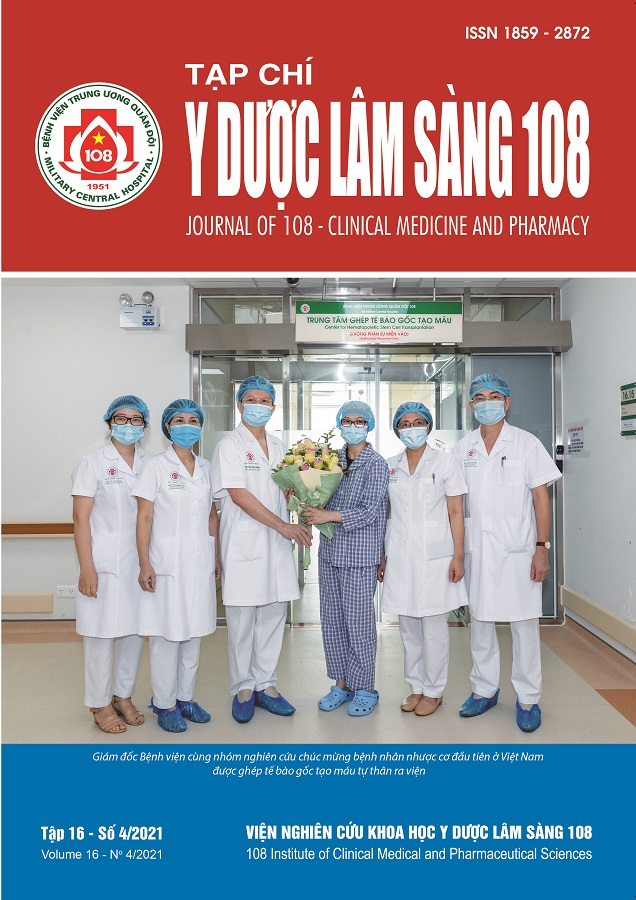Đặc điểm kỹ thuật và tính an toàn của phương pháp nút động mạch điều trị tăng sinh lành tính tuyến tiền liệt
Main Article Content
Keywords
Tóm tắt
Mục tiêu: Thống kê đặc điểm lâm sàng, kỹ thuật và tính an toàn của kỹ thuật nút động mạch tuyến tiền liệt điều trị tăng sinh lành tính tuyến tiền liệt. Đối tượng và phương pháp: Nghiên cứu can thiệp lâm sàng trên 66 bệnh nhân tăng sinh lành tính tuyến tiền liệt được điều trị nút động mạch tuyến tiền liệt tại Bệnh viện Hữu Nghị từ tháng 05/2015 đến tháng 06/2019. Kết quả: Thể tích tuyến tiền liệt trung bình của bệnh nhân trong nghiên cứu là 62,8 ± 29,86mL, điểm IPSS trung bình 30,8 ± 2,36, điểm QoL trung bình 4,7 ± 0,46 điểm. Tỷ lệ can thiệp thành công về kỹ thuật là 100%, tỷ lệ nút tắc hoàn toàn động mạch tuyến tiền liệt hai bên là 83,3%, nút tắc một bên là 16,7%. Tỷ lệ tai biến trong can thiệp là 0%. Tỷ lệ biến chứng sau can thiệp là 31,8% trong đó chủ yếu là biến chứng nhẹ và trung bình, có 1 trường hợp biến chứng nặng chiếm tỷ lệ 1,5%. Kết luận: Nút động mạch tuyến tiền liệt là phương pháp điều trị có tính an toàn cao trong điều trị tăng sinh lành tính tuyến tiền liệt.
Article Details
Các tài liệu tham khảo
2. Camara-Lopes G et al (2013) The histology of prostate tissue following prostatic artery embolization for the treatment of benign prostatic hyperplasia. Int Braz J Urol 39(2): 222-227.
3. Carnevale FC et al (2017) Anatomical variants in prostate artery embolization: A pictorial essay. Cardiovasc Intervent Radiol 40(9): 1321-1337.
4. Bhatia S et al (2017) Prostate artery embolization via transradial or transulnar versus transfemoral arterial access: Technical results. J Vasc Interv Radiol 28(6): 898-905.
5. Goncalves OM et al (2016) Comparative study using 100 - 300 versus 300 - 500 mum microspheres for symptomatic patients due to enlarged-bph prostates. cardiovasc Intervent Radiol 39(10): 1372-1378.
6. Carnevale FC et al (2017) Recurrence of lower urinary tract symptoms following prostate artery embolization for benign hyperplasia: Single center experience comparing two techniques. Cardiovasc Intervent Radiol 40(3): 366-374.
7. Bilhim T et al (2013) Unilateral versus bilateral prostatic arterial embolization for lower urinary tract symptoms in patients with prostate enlargement. Cardiovasc Intervent Radiol 36(2): 403-411.
8. Pisco JM et al (2016) Medium and long-term outcome of prostate artery embolization for patients with benign prostatic hyperplasia: Results in 630 patients. J Vasc Interv Radiol 27(8): 1115-1122.
9. Moreira AM et al (2017) A Review of adverse events related to prostatic artery embolization for treatment of bladder outlet obstruction due to BPH. Cardiovasc Intervent Radiol 40(10): 1490-1500.
10. Kisilevzky N, Laudanna Neto C, and Cividanes A (2016) Ischemia of the glans penis following prostatic artery embolization. J Vasc Interv Radiol 27(11): 1745-1747.
 ISSN: 1859 - 2872
ISSN: 1859 - 2872
